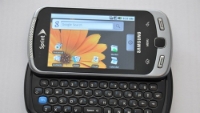Early feedback from mobile DTV test in Washington positive

After a few weeks of going live, nearly 3000 online comments have been received regarding personal experiences with the 150 ATSC-compatible handsets in the Washington, D.C., market receiving 23 channels of mobile DTV signals from nine participating local broadcasters. One of the main complaints is that after installing the necessary ATSC Mobile DTV receiver chip, the Samsung Moment phones provided to users for free loses its built-in camera functionality.
The Washington Consumer Showcase is being supported by the Open Mobile Video Coalition (OMVC) and sponsored by LG Electronics and Samsung. After initially contacting Samsung Moment owners for a free upgrade to mobile DTV capability, the trials are being expanded to include other portable DTV reception devices (laptops and portable DVD players) from Dell, LG Electronics and Valups. News programming and daytime shows are proving to be popular, according to the OMVC.
In May, the OMVC launched the Washington Consumer Showcase with the specially modified Samsung Moment phones that can receive the free mobile broadcasts. Last week, the OMVC began deploying prototypes of the first Dell Inspiron Mini 10 netbooks with mobile DTV for use by selected showcase participants in Washington. Future products to be evaluated during the Showcase include portable DVD players from LG Electronics and Tivizen mobile DTV receivers from Valups. All four devices were on display at CEA Line Shows in New York last week, where a local mobile DTV signal was being received from the local ION Media Networks affiliate.
The Washington Showcase involves nine area TV stations broadcasting 23 mobile DTV channels with dozens of programs that are now available throughout the Washington-Baltimore viewing area on specially equipped mobile DTV receiving devices. The showcase includes interactive advertising, electronic service guides for program information, closed captioning and emergency alerts.
Leveraging an online social media research platform from Harris Interactive, viewers are being asked to provide feedback through daily diaries, market research and focus groups. Among initial key findings:
- Viewers say they are excited about the potential of mobile DTV. On a scale of 1 to 10 (with 1 being "not at all excited" and 10 being "extremely excited"), initial survey participants rate mobile DTV as 7.1.
- Most viewing is happening “on the go.” Nearly two-thirds of viewing (63 percent) is being done "on the go," compared with 44 percent happening at work or at school and one-third (33 percent) of viewers saying they tune in from home.
- Viewers are tuning in multiple times a day. Just under half of viewers say they watch one or two times a day. Less than 30 percent of viewers say they watch three or more times a day.
Aaron J. Heffron, vice president of Harris Interactive, said that mobile DTV trial participants are watching TV during carpool commutes, at work and when out with the kids. We’ve had viewers praising the picture quality and the flexibility mobile DTV provides them.”
TV broadcast members of the Open Mobile Video Coalition are monitoring initial Consumer Showcase results. In addition to stations in New York and Washington, TV broadcasters are now transmitting mobile DTV signals in Detroit; Philadelphia; Charlotte, NC; Raleigh, NC; Atlanta; Orlando; Chicago; Austin; Columbus, OH; Omaha, NE; Los Angeles; San Jose, CA; Fresno, CA; and other cities.
Get the TV Tech Newsletter
The professional video industry's #1 source for news, trends and product and tech information. Sign up below.
More details from Consumer Showcase participants will be released throughout the summer, as additional features, services and devices are added for viewers’ evaluation.
